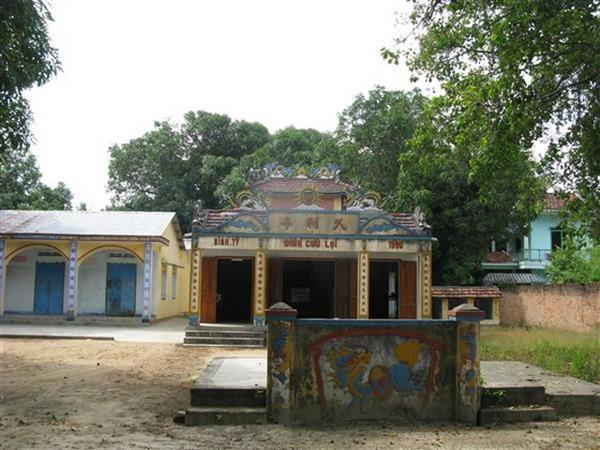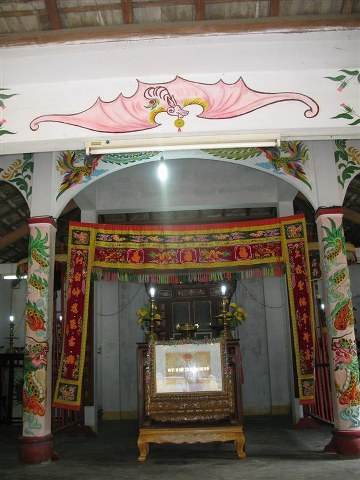Description
Cuu Loi village was formerly known as Dong Bong and today villagers still remember the folk song:
“Dong Bong is easy to come and difficult to come back
When a boy goes, one girl comes back, two."
According to the old men, Cuu Loi communal house was built in 1854 in Go Dinh land. It was built by Mr. Tong Men, born in 1812. After that, the communal house burned down and the people moved it to its present position. The communal house has been renovated a number of times as follows:
- The first time: (unknown time) after the communal house was burned down, the villagers rebuilt the communal house at the current location.
- The second time: in 1949, after the French colonialists destroyed the communal house, the villagers returned and rebuilt it with paintings.
- The third time: 1957, rebuilt with bricks, lime mortar.
- The fourth time: in 1996, the communal house and the shrine were restored.
- The fifth time: in 2003, the East house was restored.
- The sixth time: 2015, to restore the Great Hall.
The name Cuu Loi was given by Mr. Tong Van Thanh (born in 1853) with the meaning "Nine" means nine, ie 9 benefits are economic, this name has existed since ancient times. Cuu Loi Communal House turns to the Southeast. According to feng shui, the communal house takes the Truong River as the "Pre-convict" (flowing from the upper Cam Ranh dam to the front of the communal house) and the Hon Lon mountain (Hon Ngang) as the "Hau Son". Cuu Loi Communal House is located in an area of 2,755m2, with a shady mango garden. The communal house is roofed with western tiles, the roof system has an ancient floor and is attached with decorative patterns of dragons, stylized rattan...
From the outside, looking at the relic, there are the following work items: Nghi Mon and surrounding walls, Phong Nha, Martial Ca, Great Communal House, Temple of Tien Hien - Son Lam - Thanh Minh, Eastern House.

The overall plan of Cuu Loi communal house
Cuu Loi communal house worships Thanh Hoang, Former sage, Later sage, Thanh Minh, and Son Lam. In addition, the people of Cuu Loi village also worship Thien Y A Na Thanh Mau and the goddess Ngu Hanh in a small temple on the eastern edge of the village (in the middle of the field). The ordained shrine is currently kept in the communal house. The communal house management board also manages the shrine and every occasion the communal house sacrifices to the temple.

The main hall of Cuu Loi communal house
Today, Cuu Loi communal house still preserves the couplets, incense burners, gongs, drums, muo… and 04 ordinations granted by the Nguyen Dynasty kings, including:
- Sac Duy Tan in the 3rd year (1909) ordained Thien Y A Na;
- Sac Dong Khanh in the second year (1887) ordained Thien Y A Na;
- Sac Khai Dinh in the ninth year (1924) including two ordinations for Bon Canh Thanh Hoang and Thien Y A Na.
According to tradition, the communal house opens once every three years, lasts for three days on the 15th, 16th and 17th of the third lunar month and has a boi singing ceremony.
Rituals during the festival:
- Birth ceremony
- Sacrifice ceremony
- Worshiping ceremony for Thien Y An Na and the goddess of the Five Elements
- Singing ceremony
- Funeral ceremony.
During the years of resistance war against Japanese fascists, French colonialists and American imperialists, the people of Cuu Loi joined the whole country to fight against foreign invaders. The village had a heroic Vietnamese mother and twenty-two martyrs. Before 1945, Cuu Loi village had only about 70 households. In 1946, knowing that the communal house was the meeting place of revolutionary cadres, the French colonialists destroyed the communal house, leaving only four pillars. In 1949, the people after returning home rebuilt the communal house and this continued to be the communication base of the revolution. After the unification of the country, the communal house became the meeting place of the government and people in the village. Experiencing the ups and downs of the nation's history, today, although Cuu Loi communal house no longer retains the old architecture, it still becomes a vestige of history.
Noting the above typical values of the relic, on 12/11/2007, Cuu Loi communal house was ranked as a provincial historical - cultural relic by Khanh Hoa Provincial People's Committee, in Decision No. 2019/QD-UBND.
